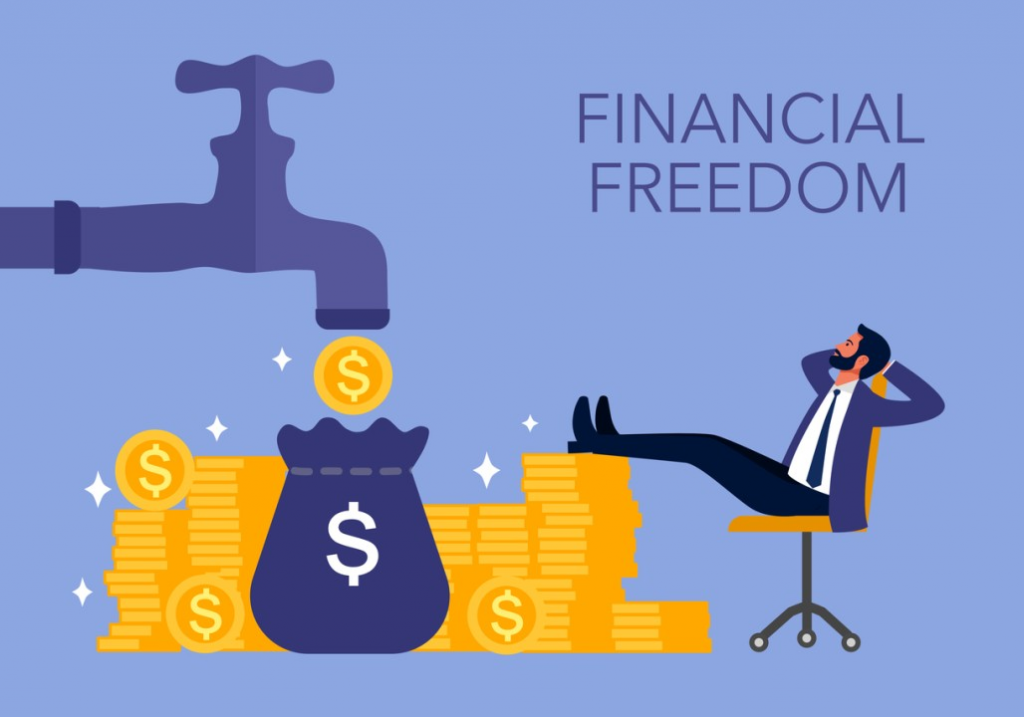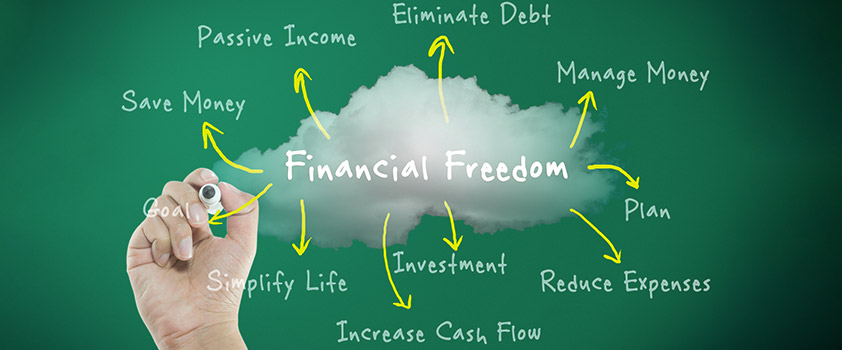Financial freedom is a goal that many people dream of, but few fully understand or actively pursue. It’s often associated with wealth, early retirement, or not needing to work but at its core, financial freedom means having control over your money, rather than letting money control you.
Achieving financial freedom doesn’t require winning the lottery or earning six figures. It’s about building smart habits, creating multiple streams of income, and making intentional choices over time. With the right mindset and plan, anyone can work toward a life where money is a tool, not a burden.
This guide will walk you through what financial freedom really means and how to reach it step by step.
What Is Financial Freedom?
Financial freedom is the ability to make life decisions without being overly stressed about the financial impact. It means having enough income either from savings, investments, or passive income sources to cover your living expenses without being dependent on a paycheck.
People who achieve financial freedom can:
- Retire early or work by choice
- Travel without worrying about money
- Spend time with family and pursue hobbies
- Handle emergencies without going into debt
It’s not about being rich it’s about being secure and free.
Step 1: Shift Your Financial Mindset
Your mindset is the foundation of your financial journey. Many people grow up with limiting beliefs like “I’m bad with money” or “I’ll never be able to save enough.” These thoughts can hold you back more than any salary ever could.
To build a financial freedom mindset:
- Believe that long-term wealth is possible, even if you’re starting small
- Focus on growth, discipline, and consistency
- Learn from mistakes rather than giving up
- Practice delayed gratification and value long-term security over short-term pleasure
Financial success is 80% behavior and 20% knowledge. The way you think about money matters.
Step 2: Track and Control Your Spending
You can’t improve what you don’t measure. The first step toward financial freedom is understanding where your money is going each month.
Track your income and expenses using a notebook, spreadsheet, or apps like Mint, YNAB, or Spendee. Once you have a clear picture, create a realistic monthly budget that includes:
- Basic needs (rent, food, utilities)
- Debt repayment
- Emergency fund contributions
- Long-term savings or investments
- A small amount for personal enjoyment
The goal isn’t to restrict your life, but to take control of your spending so your money works for you not the other way around.
Step 3: Build an Emergency Fund
Unexpected expenses are one of the biggest threats to financial stability. A sudden medical bill, car repair, or job loss can quickly wipe out your progress if you’re unprepared.
That’s why having an emergency fund is essential. Start with a goal of saving $1,000. Then work toward three to six months’ worth of essential living expenses in a separate, easily accessible account. This fund gives you peace of mind and prevents you from falling into debt when life gets unpredictable.

Step 4: Pay Off High-Interest Debt
Debt is one of the biggest obstacles to financial freedom. Credit card balances, payday loans, and other high-interest debt can trap you in a cycle of monthly payments that eat away at your income.
There are two main strategies to eliminate debt:
- Debt snowball: Pay off the smallest balances first for quick wins
- Debt avalanche: Pay off the highest-interest debts first to save the most money
Choose the method that keeps you motivated. Once you’re debt-free, redirect those payments toward saving and investing.
Step 5: Create Multiple Streams of Income
Relying solely on one paycheck is risky. Financially free individuals usually have several income sources some active, some passive.
Here are a few ways to increase or diversify your income:
- Freelancing or side hustles: Use your skills to earn extra money outside your main job
- Rental income: Invest in property and rent it out
- Dividend-paying stocks: Earn regular income from investments
- Create digital products or courses: Build assets that generate passive income over time
- Start a small business or monetize a hobby
Building multiple income streams reduces financial stress and accelerates your path to independence.
Step 6: Invest Consistently for the Long Term
Investing is key to long term wealth and financial freedom. Saving money is important, but investing allows your money to grow and compound over time.
You don’t need to be an expert to start. Begin with simple, low-cost investments such as:
- Index funds and ETFs that track the overall market
- Retirement accounts like 401(k)s or IRAs
- Robo-advisors that automate investing based on your goals and risk tolerance
Invest consistently, even in small amounts. The earlier you start, the more time your money has to grow.
Step 7: Set Clear Financial Goals
Having a vision keeps you focused and motivated. Set short-term, medium-term, and long-term financial goals, such as:
- Saving $10,000 in one year
- Paying off a student loan in 18 months
- Reaching $100,000 in net worth in five years
Write your goals down, break them into milestones, and track your progress regularly. Financial freedom isn’t just about discipline it’s also about purpose.
Step 8: Maintain the Habit
Reaching financial freedom isn’t a one-time event. It requires ongoing effort, discipline, and awareness. Review your finances monthly. Adjust your budget as your income, goals, and lifestyle change. Reinvest profits. Continue learning about personal finance.
Surround yourself with like-minded people or join communities that support your goals. Staying consistent over time is what separates those who dream about financial freedom from those who achieve it.
Financial Freedom: How to Take Control of Your Money and Your Future
Financial freedom is a goal many people dream about, but few truly understand or actively work toward. While it’s often linked to wealth, early retirement, or not having to work, its core meaning is simpler: having control over your money instead of letting money control you.
Achieving financial freedom doesn’t require winning the lottery or earning a six-figure salary. It’s about building smart habits, creating multiple income streams, and making intentional choices over time. With the right mindset and plan, anyone can work toward a life where money is a tool, not a burden.
What Is Financial Freedom?

Financial freedom is the ability to make life decisions without being overly stressed about the financial impact. It means having enough income from savings, investments, or passive sources to cover living expenses without relying entirely on a paycheck.
Those who reach financial freedom can:
- Retire early or work purely by choice.
- Travel without constant financial worry.
- Spend time with family and pursue hobbies freely.
- Handle emergencies without falling into debt.
It’s not about being rich it’s about being secure and free.
1. Shift Your Financial Mindset
Your mindset is the foundation of your journey. Many people grow up with limiting beliefs like “I’m bad with money” or “I’ll never save enough.” These mental blocks can do more damage than a low salary.
To build a financial freedom mindset:
- Believe long-term wealth is possible, even starting small.
- Focus on discipline, consistency, and growth.
- Learn from mistakes instead of quitting.
- Practice delayed gratification valuing long-term security over short-term pleasure.
Remember: Financial success is 80% behavior and 20% knowledge. How you think about money matters.
2. Track and Control Your Spending
You can’t improve what you don’t measure. The first step is to know where your money goes.
How to start:
- Track every expense for at least one month.
- Use tools like Mint, YNAB, or a simple spreadsheet.
- Categorize into needs, wants, savings, and debt repayment.
The goal isn’t restriction it’s control. When you tell your money where to go, it works for you instead of disappearing without purpose.
3. Build an Emergency Fund
Unexpected expenses can wreck financial progress. Medical bills, car repairs, or job loss are part of life the question is whether you’re prepared.
Action plan:
- First goal: $1,000 for immediate protection.
- Next: 3–6 months of essential expenses in a separate savings account.
- Use only for genuine emergencies.
Example: If your monthly needs are $2,000, aim for $6,000–$12,000 as a full emergency fund.
4. Pay Off High-Interest Debt
Debt drains your income and delays freedom.
Two proven repayment strategies:
- Snowball – Pay smallest balances first for quick wins.
- Avalanche – Pay highest interest first to save more.
Once debt-free, redirect those payments to investments. Treat it like giving yourself a raise.
5. Create Multiple Streams of Income
Relying on a single paycheck is risky. Financially free people often have multiple income sources.
Options include:
- Freelancing or side gigs.
- Rental properties or Airbnb.
- Dividend-paying stocks.
- Selling digital products or courses.
- Small business or monetized hobby.
Even $500 extra per month invested can grow into tens of thousands over time.

6. Invest Consistently for the Long Term
Saving keeps your money safe; investing makes it grow.
Start simple:
- Index funds & ETFs – Low-cost, diversified, and effective.
- Retirement accounts – 401(k), IRA, Roth IRA for tax advantages.
- Robo-advisors – Automated investing based on your goals.
$500/month at 8% annual return grows to over $745,000 in 30 years thanks to compounding.
7. Set Clear, Measurable Goals
General wishes like “I want to be rich” don’t work. Specific goals give you direction.
Examples:
- Save $10,000 in 18 months.
- Pay off student loans in 2 years.
- Reach $100,000 net worth in 5 years.
Break large goals into milestones and celebrate each achievement.
8. Protect Your Progress
As your wealth grows, protect it:
- Have adequate insurance.
- Keep personal and business finances separate.
- Avoid speculative “get rich quick” schemes.
- Stay financially educated.
9. Live Below Your Means (Without Sacrificing Happiness)
Freedom isn’t about living cheap it’s about spending intentionally. Cut ruthlessly on what doesn’t add value, and spend freely on what truly matters to you.
Example: Skip yearly car upgrades but take the family on meaningful vacations.
10. Maintain the Habit
Financial freedom isn’t a finish line it’s a lifestyle.
Review your budget monthly, rebalance investments annually, and keep learning. Surround yourself with like-minded people who encourage smart financial behavior.
Why This Works
These steps work because they combine discipline, income growth, and long-term investing.
- Your mindset sets the foundation.
- Tracking and budgeting give you control.
- Debt elimination and emergency funds remove risk.
- Multiple incomes and investments accelerate growth.
The formula is simple, but it requires patience and consistency.
Final Thoughts
Financial freedom is possible for anyone regardless of starting point.
Whether you begin with $10 or $10,000, the path is the same:
- Gain control of your spending.
- Eliminate bad debt.
- Save and invest regularly.
- Protect and grow your wealth.
The sooner you start, the sooner you’ll live a life where money gives you options, not stress.
